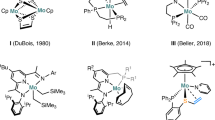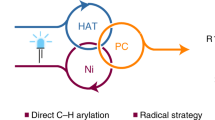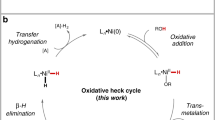Abstract
Catalytic olefin hydrogenation is ubiquitous in organic synthesis. In most proposed homogeneous catalytic cycles, reactive M–H bonds are generated either by oxidative addition of H2 to a metal centre or by deprotonation of a non-classical metal dihydrogen (M–H2) intermediate. Here we provide evidence for an alternative H2-activation mechanism that instead involves direct ligand-to-ligand hydrogen transfer (LLHT) from a metal-bound H2 molecule to a metal-coordinated olefin. An unusual pincer ligand that features two phosphine ligands and a central olefin supports the formation of a non-classical Ni–H2 complex and the Ni(alkyl)(hydrido) product of LLHT, in rapid equilibrium with dissolved H2. The usefulness of this cooperative H2-activation mechanism for catalysis is demonstrated in the semihydrogenation of diphenylacetylene. Experimental and computational mechanistic investigations support the central role of LLHT for H2 activation and catalytic semihydrogenation. The product distribution obtained is largely determined by the competition between (E)–(Z) isomerization and catalyst degradation by self-hydrogenation.

This is a preview of subscription content, access via your institution
Access options
Access Nature and 54 other Nature Portfolio journals
Get Nature+, our best-value online-access subscription
$29.99 / 30 days
cancel any time
Subscribe to this journal
Receive 12 print issues and online access
$259.00 per year
only $21.58 per issue
Buy this article
- Purchase on Springer Link
- Instant access to full article PDF
Prices may be subject to local taxes which are calculated during checkout





Similar content being viewed by others
Data availability
The data supporting the findings of this study are provided in the Article and its Supplementary Information and are also available from the corresponding author on reasonable request. Further experimental details, spectra of compounds, crystallographic details and additional discussions of computational details are provided in the Supplementary Information. Coordinates of all computed structures (energy minima and transitions states) are provided in the .xyz format. CCDC 2236144 (compound 5) contains the Supplementary Data for this paper. These data can be obtained free of charge from The Cambridge Crystallographic Data Centre via www.ccdc.cam.ac.uk/data_request/cif. Source Data are provided with this paper.
References
McGlynn, S. E. et al. Hydrogenation reactions of carbon on Earth: linking methane, margarine, and life. Am. Mineral. 105, 599–608 (2020).
Kubas, G. J. Chemistry of saturated molecules. Proc. Natl Acad. Sci. USA 104, 6901–6907 (2007).
Kubas, G. J. Catalytic processes involving dihydrogen complexes and other sigma-bond complexes. Catal. Lett. 104, 79–101 (2005).
Crabtree, R. H. Dihydrogen complexation. Chem. Rev. 116, 8750–8769 (2016).
Hale, D. J., Ferguson, M. J. & Turculet, L. (PSiP)Ni-catalyzed (E)-selective semihydrogenation of alkynes with molecular hydrogen. ACS Catal. 12, 146–155 (2021).
Kubas, G. J. Activation of dihydrogen and coordination of molecular H2 on transition metals. J. Organomet. Chem. 751, 33–49 (2014).
Kubas, G. J. Metal–dihydrogen and σ-bond coordination: the consummate extension of the Dewar–Chatt–Duncanson model for metal–olefin π bonding. J. Organomet. Chem. 635, 37–68 (2001).
Kubas, G. J. Fundamentals of H2 binding and reactivity on transition metals underlying hydrogenase function and H2 production and storage. Chem. Rev. 107, 4152–4205 (2007).
Vollmer, M. V., Xie, J. & Lu, C. C. Stable dihydrogen complexes of cobalt(–I) suggest an inverse trans-influence of Lewis acidic group 13 metalloligands. J. Am. Chem. Soc. 139, 6570–6573 (2017).
Jessop, P. G. & Morris, R. H. Reactions of transition metal dihydrogen complexes. Coord. Chem. Rev. 121, 155–284 (1992).
Alig, L., Fritz, M. & Schneider, S. First-row transition metal (de)hydrogenation catalysis based on functional pincer ligands. Chem. Rev. 119, 2681–2751 (2019).
Manar, K. K. & Ren, P. in Advances in Organometallic Chemistry Vol. 76 (Elsevier Inc., 2021).
Karunananda, M. K. & Mankad, N. P. Cooperative strategies for catalytic hydrogenation of unsaturated hydrocarbons. ACS Catal. 7, 6110–6119 (2017).
Grotjahn, D. B. Bifunctional organometallic catalysts involving proton transfer or hydrogen bonding. Chem. Eur. J. 11, 7146–7153 (2005).
Tiddens, M. R. & Moret, M.-E. Top. Organomet. Chem. 68, 25–69 (2021).
Elsby, M. R. & Baker, R. T. Strategies and mechanisms of metal–ligand cooperativity in first-row transition metal complex catalysts. Chem. Soc. Rev. 49, 8933–8987 (2020).
Milstein, D. Metal–ligand cooperation by aromatization–dearomatization as a tool in single bond activation. Philos. Trans. R. Soc. A 373, 20140189 (2015).
Van Der Vlugt, J. I. Cooperative catalysis with first-row late transition metals. Eur. J. Inorg. Chem. 2012, 363–375 (2012).
Grützmacher, H. Cooperating ligands in catalysis. Angew. Chem. Int. Ed. 47, 1814–1818 (2008).
He, T. et al. Mechanism of heterolysis of H2 by an unsaturated d8 nickel center: via tetravalent nickel. J. Am. Chem. Soc. 132, 910–911 (2010).
Schneider, S., Meiners, J. & Askevold, B. Cooperative aliphatic PNP amido pincer ligands-versatile building blocks for coordination chemistry and catalysis. Eur. J. Inorg. Chem. 2012, 412–429 (2012).
Harman, W. H. & Peters, J. C. Reversible H2 addition across a nickel-borane unit as a promising strategy for catalysis. J. Am. Chem. Soc. 134, 5080–5082 (2012).
Harman, W. H., Lin, T. P. & Peters, J. C. A d10 Ni–(H2) adduct as an intermediate in H–H oxidative addition across a Ni–B bond. Angew. Chem. Int. Ed. 53, 1081–1086 (2014).
Karunananda, M. K. & Mankad, N. P. E-selective semi-hydrogenation of alkynes by heterobimetallic catalysis. J. Am. Chem. Soc. 137, 14598–14601 (2015).
Kubas, G. J., Ryan, R. R., Swanson, B. I., Vergamini, P. J. & Wasserman, H. J. Characterization of the first examples of isolable molecular hydrogen complexes, M(CO)3(PR3)2(H2). J. Am. Chem. Soc. 106, 451–452 (1984).
Bianchini, C. et al. Selective hydrogenation of 1-alkynes to alkenes catalyzed by an iron(II) cis-hydride η2-dihydrogen complex. A case of intramolecular reaction between η2-H2 and-σ-vinyl ligands. Organometallics 11, 138–145 (1992).
Thomas, A., Haake, M., Grevels, F. ‐W. & Bargon, J. In situ NMR investigations of photocatalyzed hydrogenations with parahydrogen in the presence of metal carbonyl compounds of group 6. Angew. Chem. Int. Ed. 33, 755–757 (1994).
Joshi, A. M., MacFarlane, K. S. & James, B. R. Kinetics and mechanism of H2-hydrogenation of styrene catalyzed by [RuCl(dppb) (μ-Cl)]2 (dppb = 1,4-bis(dipphenylphosphino)butane). Evidence for hydrogen transfer from a dinuclear molecular hydrogen species. J. Organomet. Chem. 488, 161–167 (1995). .
Kirss, R. U., Eisenschmid, T. C. & Eisenberg, R. Para-hydrogen induced polarization in hydrogenation reactions catalyzed by ruthenium-phosphine complexes. J. Am. Chem. Soc. 110, 8564–8566 (1988).
Jia, G., Ng, W. S. & Lau, C. P. Dihydrogen complex formation and C–C bond cleavage from protonation of Cp*RuH(diene) complexes. Organometallics 17, 4538–4540 (1998).
Kubas, G. J. Metal Dihydrogen and σ-Bond Complexes (Springer, 2001); https://doi.org/10.1007/b113929
Vigalok, A., Kraatz, H., Konstantinovsky, L. & Milstein, D. Evidence for direct trans insertion in a hydrido–olefin rhodium complex—free nitrogen as a trap in a migratory insertion process. Chem. Eur. J 3, 253–260 (1997).
Polukeev, A. V. & Wendt, O. F. Iridium pincer complexes with an olefin backbone. Organometallics 34, 4262–4271 (2015).
Polukeev, A. V. & Wendt, O. F. Iridium complexes with aliphatic, non-innocent pincer ligands. J. Organomet. Chem. 867, 33–50 (2018).
Verhoeven, D. G. A. & Moret, M. E. Metal-ligand cooperation at tethered π-ligands. Dalton Trans. 45, 15762–15778 (2016).
Comanescu, C. C., Vyushkova, M. & Iluc, V. M. Palladium carbene complexes as persistent radicals. Chem. Sci. 6, 4570–4579 (2015).
Barrett, B. J. & Iluc, V. M. An adaptable chelating diphosphine ligand for the stabilization of palladium and platinum carbenes. Organometallics 36, 730–741 (2017).
Barrett, B. J. & Iluc, V. M. Group 10 metal complexes supported by pincer ligands with an olefinic backbone. Organometallics 33, 2565–2574 (2014).
Barrett, B. J. & Iluc, V. M. Coordination of a hemilabile pincer ligand with an olefinic backbone to mid-to-late transition metals. Inorg. Chem. 53, 7248–7259 (2014).
Breitenfeld, J., Vechorkin, O., Corminboeuf, C., Scopelliti, R. & Hu, X. Why are (NN2)Ni pincer complexes active for alkyl–alkyl coupling: β-H elimination is kinetically accessible but thermodynamically uphill. Organometallics 29, 3686–3689 (2010).
Crabtree, R. H. The Organometallic Chemistry of the Transition Metals (John Wiley & Sons, 2014); https://doi.org/10.1002/9781118788301
Michaliszyn, K., Smirnova, E. S., Bucci, A., Martin‐Diaconescu, V. & Lloret Fillol, J. Well‐defined nickel P3C complexes as hydrogenation catalysts of N‐heteroarenes under mild conditions. ChemCatChem 14, e202200039 (2022).
Guihaumé, J., Halbert, S., Eisenstein, O. & Perutz, R. N. Hydrofluoroarylation of alkynes with Ni catalysts. C–H activation via ligand-to-ligand hydrogen transfer, an alternative to oxidative addition. Organometallics 31, 1300–1314 (2012).
Perutz, R. N., Sabo-Etienne, S. & Weller, A. S. Metathesis by partner interchange in σ-bond ligands: expanding applications of the σ-CAM mechanism. Angew. Chem. Int. Ed. 61, e202111462 (2022).
Tang, S., Eisenstein, O., Nakao, Y. & Sakaki, S. Aromatic C–H σ-bond activation by Ni0, Pd0 and Pt0 alkene complexes: concerted oxidative addition to metal vs ligand-to-ligand H transfer mechanism. Organometallics 36, 2761–2771 (2017).
Perutz, R. N. & Sabo-Etienne, S. The σ-CAM mechanism: σ complexes as the basis of σ-bond metathesis at late-transition-metal centers. Angew. Chem. Int. Ed. 46, 2578–2592 (2007).
Murugesan, K. et al. Nickel-catalyzed stereodivergent synthesis of E- and Z-alkenes by hydrogenation of alkynes. ChemSusChem 12, 3363–3369 (2019).
Ramirez, B. L. & Lu, C. C. Rare-earth supported nickel catalysts for alkyne semihydrogenation: chemo- and regioselectivity impacted by the Lewis acidity and size of the support. J. Am. Chem. Soc. 142, 5396–5407 (2020).
Thiel, N. O., Kaewmee, B., Tran Ngoc, T. & Teichert, J. F. A simple nickel catalyst enabling an E-selective alkyne semihydrogenation. Chem. Eur. J. 26, 1597–1603 (2020).
Swamy, K. C. K., Reddy, A. S., Sandeep, K. & Kalyani, A. Advances in chemoselective and/or stereoselective semihydrogenation of alkynes. Tetrahedron Lett. 59, 419–429 (2018).
Gregori, B. J., Schmotz, M.-O. W. S. & Jacobi von Wangelin, A. Stereoselective semi‐hydrogenations of alkynes by first‐row (3d) transition metal catalysts. ChemCatChem 14, e202200886 (2022).
Sansores‐Paredes, M. L. G., Voort, S., Lutz, M. & Moret, M. Divergent reactivity of an isolable nickelacyclobutane. Angew. Chem. Int. Ed. 60, 26518–26522 (2021).
Gullett, K. L. et al. Dihydrogen and Dinitrogen Complexes of Cobalt and Nickel. Comprehensive Coordination Chemistry III Vol. 6 (Elsevier, 2021).
Morris, R. H. Dihydrogen, dihydride and in between: NMR and structural properties of iron group complexes. Coord. Chem. Rev. 252, 2381–2394 (2008).
Luther, T. A. & Heinekey, D. M. Synthesis, characterization, and reactivity of dicationic dihydrogen complexes of osmium and ruthenium. Inorg. Chem. 37, 127–132 (1998).
Cammarota, R. C. & Lu, C. C. Tuning nickel with Lewis acidic group 13 metalloligands for catalytic olefin hydrogenation. J. Am. Chem. Soc. 137, 12486–12489 (2015).
Cammarota, R. C. et al. Thermodynamic and kinetic studies of H2 and N2 binding to bimetallic nickel-group 13 complexes and neutron structure of a Ni(η2-H2) adduct. Chem. Sci. 10, 7029–7042 (2019).
Connor, B. A., Rittle, J., Vandervelde, D. & Peters, J. C. A Ni0(η2-(Si–H))(η2-H2) complex that mediates facile H atom exchange between two σ-ligands. Organometallics 35, 686–690 (2016).
Tsay, C. & Peters, J. C. Thermally stable N2 and H2 adducts of cationic nickel(II). Chem. Sci. 3, 1313–1318 (2012).
Connelly, S. J., Zimmerman, A. C., Kaminsky, W. & Heinekey, D. M. Synthesis, structure, and reactivity of a nickel dihydrogen complex. Chem. Eur. J. 18, 15932–15934 (2012).
Robinson, S. J. C. & Heinekey, D. M. Hydride & dihydrogen complexes of earth abundant metals: structure, reactivity, and applications to catalysis. Chem. Commun. 53, 669–676 (2017).
Prat, J. R., Cammarota, R. C., Graziano, B. J., Moore, J. T. & Lu, C. C. Toggling the Z-type interaction off-on in nickel-boron dihydrogen and anionic hydride complexes. Chem. Commun. 58, 8798–8801 (2022).
Cammarota, R. C. et al. A bimetallic nickel–gallium complex catalyzes CO2 hydrogenation via the intermediacy of an anionic d10 nickel hydride. J. Am. Chem. Soc. 139, 14244–14250 (2017).
Lu, T. & Chen, F. Multiwfn: a multifunctional wavefunction analyzer. J. Comput. Chem. 33, 580–592 (2012).
Vastine, B. A. & Hall, M. B. Carbon–hydrogen bond activation: two, three, or more mechanisms? J. Am. Chem. Soc. 129, 12068–12069 (2007).
Skipper, C. V. J., Hoang, T. K. A., Antonelli, D. M. & Kaltsoyannis, N. Transition metal hydrazide-based hydrogen-storage materials: the first atoms-in-molecules analysis of the Kubas interaction. Chem. Eur. J. 18, 1750–1760 (2012).
Sparkes, H. A., Chaplin, A. B., Weller, A. S. & Howard, J. A. K. Bond catastrophes in rhodium complexes: experimental charge-density studies of [Rh(C7H8)(PtBu3)Cl] and [Rh(C7H8)(PCy3)Cl]. Acta Crystallogr. B 66, 503–514 (2010).
Bair, J. S. et al. Linear-selective hydroarylation of unactivated terminal and internal olefins with trifluoromethyl-substituted arenes. J. Am. Chem. Soc. 136, 13098–13101 (2014).
Chen, M. & Montgomery, J. Nickel-catalyzed intermolecular enantioselective heteroaromatic C–H alkylation. ACS Catal. 12, 11015–11023 (2022).
Saper, N. I. et al. Nickel-catalysed anti-Markovnikov hydroarylation of unactivated alkenes with unactivated arenes facilitated by non-covalent interactions. Nat. Chem. 12, 276–283 (2020).
Orsino, A. F., Gutiérrez Del Campo, M., Lutz, M. & Moret, M. E. Enhanced catalytic activity of nickel complexes of an adaptive diphosphine-benzophenone ligand in alkyne cyclotrimerization. ACS Catal. 9, 2458–2481 (2019).
Lesueur, W., Solari, E., Floriani, C., Chiesi-Villa, A. & Rizzoli, C. A bidentate bisphosphine functioning in intramolecular aliphatic metalation and as an NMR spectroscopic probe for the metal coordination environment. Inorg. Chem. 36, 3354–3362 (1997).
Ryu, H. et al. Pitfalls in computational modeling of chemical reactions and how to avoid them. Organometallics 37, 3228–3239 (2018).
Basics on Arrayed-NMR and Data Analysis (Resources, accessed January 2023); https://resources.mestrelab.com/data-analysis/
Schreurs, A. M. M., Xian, X. & Kroon-Batenburg, L. M. J. EVAL15: a diffraction data integration method based on ab initio predicted profiles. J. Appl. Crystallogr. 43, 70–82 (2010).
Krause, L., Herbst-Irmer, R., Sheldrick, G. M. & Stalke, D. Comparison of silver and molybdenum microfocus X-ray sources for single-crystal structure determination. J. Appl. Crystallogr. 48, 3–10 (2015).
Sheldrick, G. M. SHELXT—integrated space-group and crystal-structure determination. Acta Crystallogr. A 71, 3–8 (2015).
Sheldrick, G. M. Crystal structure refinement with SHELXL. Acta Crystallogr. C 71, 3–8 (2015).
Spek, A. L. Structure validation in chemical crystallography. Acta Crystallogr. D 65, 148–155 (2009).
Frisch, M. J. et al. Gaussian 16 Revision C.01 (Gaussian, Inc., 2016).
Acknowledgements
This project has received funding from the European Research Council (ERC) under the European Union’s Horizon 2020 research and innovation program (grant agreement no. 715060). The X-ray diffractometer has been financed by the Netherlands Organization for Scientific Research (NWO). This work made use of the Dutch national e-infrastructure with the support of the SURF Cooperative using grants no. EINF-1254 and EINF-3520. The funders had no role in study design, data collection and analysis, decision to publish or preparation of the manuscript. We thank P. M. Pérez-García for his assistance with the analysis of the catalysis results and helpful discussions. We thank G. van Koten, W. Hill Harman, D. L. J. Broere and A. A. Thevenon-Kozub for insightful discussions.
Author information
Authors and Affiliations
Contributions
M.-E.M. initiated and supervised the project. M.L.G.S-P. performed the experiments and DFT calculations. M.L. oversaw the acquisition, solving and interpretation of X-ray diffraction of the crystal structure. M.L.G.S-P. and M.-E.M. wrote the manuscript with the contribution of M.L. All authors approved the final manuscript.
Corresponding author
Ethics declarations
Competing interests
The authors declare no competing interests.
Peer review
Peer review information
Nature Chemistry thanks Alison Edwards, Helene Gerard and Robin Perutz for their contribution to the peer review of this work.
Additional information
Publisher’s note Springer Nature remains neutral with regard to jurisdictional claims in published maps and institutional affiliations.
Supplementary information
Supplementary Information
Experimental Details, Sections 1–5, Figs. 1–82 and Tables 1–4.
Supplementary Data 1
Coordinates of all computed structures in.xyz format.
Supplementary Data 2
Crystallographic data for compound 5 (CCDC no. 2236144).
Supplementary Data 3
Source numerical data from NMR integration for Supplementary Figs. 20, 21, 26, 29, 30.
Source data
Source Data Fig. 4
Numerical data from NMR integration for Fig. 4.
Rights and permissions
Springer Nature or its licensor (e.g. a society or other partner) holds exclusive rights to this article under a publishing agreement with the author(s) or other rightsholder(s); author self-archiving of the accepted manuscript version of this article is solely governed by the terms of such publishing agreement and applicable law.
About this article
Cite this article
Sansores-Paredes, M.L.G., Lutz, M. & Moret, ME. Cooperative H2 activation at a nickel(0)–olefin centre. Nat. Chem. 16, 417–425 (2024). https://doi.org/10.1038/s41557-023-01380-1
Received:
Accepted:
Published:
Issue Date:
DOI: https://doi.org/10.1038/s41557-023-01380-1



